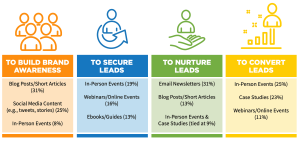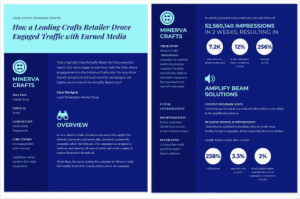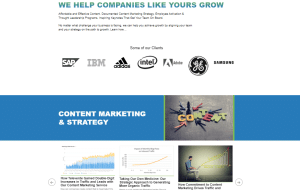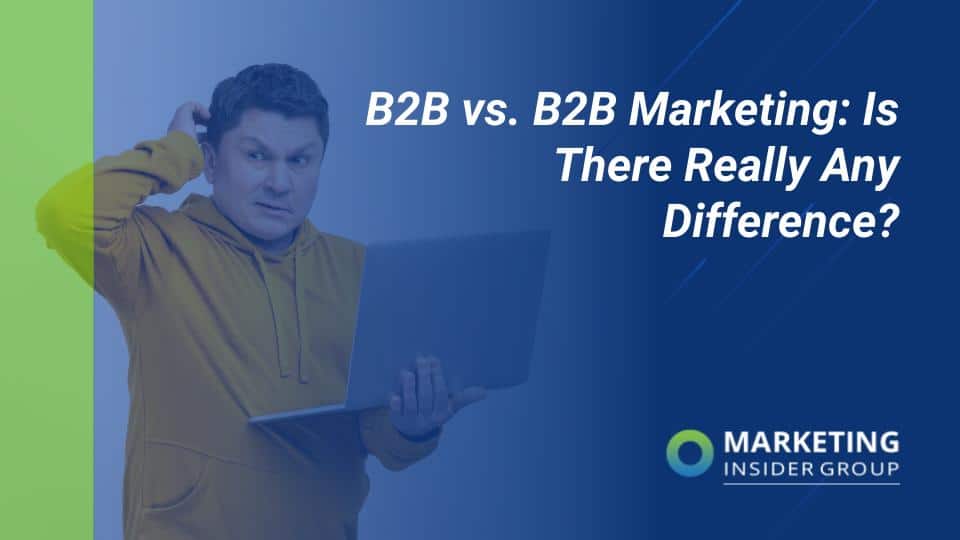
How to Create a Case Study That Impresses Any Client
A great case study is like gold for marketing and sales teams looking to drive conversions.
This is particularly true in the B2B world, where potential clients are looking for proof of long-term results with other companies before making their own buying decision. Knowing how to create a case study that clearly demonstrates your company’s ability to deliver is key to a complete B2B marketing strategy.
Recent research shows that 73% of B2B marketers are using case studies as part of their content marketing strategy, so it’s essential that yours truly stand out.
We’ve put together a list of 7 actionable ways you can create case studies that impress your potential clients and directly contribute to increasing conversions and sales.
Quick Takeaways
- Case studies are most relevant to potential clients in the later stages of the buyer journey.
- It’s essential that case studies use specifics to describe the client, the problem or need, and the solution.
- You can make your case studies most impactful by using real numbers, examples, and client testimonials.
- Including visuals in your case studies make them more memorable and engaging.
- Your library of case studies should be visible and accessible on your website’s main navigation menu.
Where do case studies fit in your buyer journey?
The key to learning how to create a case study that drives results is having a true understanding of where they fit in your buyer journey.
Did you know that the average B2B buyer journey lasts several months? Your customers do much of their own research online before reaching out to your company. During that time, your content is doing the work of convincing them you’re the best opinion.
Case studies are a big part of that. Understanding your potential customer’s motivation for seeking out and reading case studies makes you better able to craft them in ways that make an impact.
Most marketers agree that case studies fall into the later stages of the buyer journey: the consideration and decision phases. In these phases, you’ve already captured your leads. Now you’re focusing on nurturing and converting them.

What does this tell us?
Potential customers at these stages likely know who your company is and what you do. You don’t need to spend a ton of time providing that information in your case studies. Instead, it’s time to get right to the point and demonstrate how you deliver on your promises and provide real value to your clients.
How to create a case study that impresses clients
Make your case studies relatable
The primary purpose of case studies is to demonstrate exactly how you add value for clients by addressing their unique problems and needs. The best way to ensure you accomplish this goal is to focus on making your case studies relatable.
Think about your ideal client. What is their industry? What are the most pressing problems and needs they present when they reach out to your company?
You want to develop case studies that align with these answers so that when your potential client reads them, they feel the content is relevant to their situation. When they do, they are more likely to trust that you can help them in the same way.
It’s possible that you work with clients in many industries and with a wide range of needs and problems that you help them address. When this is the case, develop case studies from a diverse set of clients and situations so that you have something relatable to share with all of your prospective buyers.
Be very specific
Don’t skip over the details when you’re creating a new case study. Even in cases where you have to maintain client confidentiality or leave some particular piece of information out at the client’s request, always be as specific as possible with the content you do include.
Here are some key areas you need to be as specific as possible:
Your client
Get specific about who your client is.
If you can use their name, do so. If not, describe them as clearly as you can. For example, if your client is Walmart (impressive!) and you can’t say that directly, you could say “One of the world’s largest retailers, with more than 2 million employees and thousands of store locations across the country.”
In some cases, even a description that leaves out a company’s name can give away their identity. If anonymity is a concern for your client, check with them about your description. In most cases, you’ll be able to find a balance that maintains their privacy while including the details you need to provide strong context in your case study.
The problem or need
Don’t gloss over the problem in an effort to get right to the results. Results are of course important (and we’ll talk more about them later on), but the part of your case study likely to be most relatable for your potential client is the problem. You want them to think “Yes, this is exactly what we’re dealing with!” when they read your case study.
Results
Being specific when you discuss results gives your case study more power. Use real numbers and metrics to demonstrate results. Show in very clear terms how your company added value for your client (i.e. what benefits are they now experiencing as a direct result of working with you).
Tell the complete story
This one’s important. Your case studies need to be clear and straightforward, but they also need to tell the complete story. Start with your first interactions with your client and tell the story all the way through to long-term results.
Here’s a simply overview of the important components every case study should include:

Telling the complete story means you may need to practice patience in your case study strategy.
Wait until your client has truly experienced the results you promised to deliver before you write a case study about them. Update previously written case studies to include results over a longer time and any additional important information your client shares.
Keep in mind that most client-company relationships are not perfectly linear. Don’t shy away from discussing setbacks you and your client experienced. Instead, consider it an opportunity to show how you remained resilient and found solutions in the face of unexpected challenges.
Demonstrate clear results
While the problem or challenge section of your case study may be the one that’s most relatable to clients, the results section is what they care about the most. Your results section is where you truly demonstrate the value of your brand and the solutions you can provide.
The results section is the pinnacle of the story you’re telling. Build up to the results section of and make it a strong culmination of the other sections. Be specific about what was achieved and use real numbers and examples to demonstrate it.
The last thing you want is for your results section to be ambiguous in any way. If the point of your case study is to show how you deliver for clients (and it is) then your results section is the place to drive that home.
Include quotes and testimonials
Get this: 97% of B2B customers cited testimonials and peer recommendations as the most reliable type of content. To boot, 92% of B2B buyers are more likely to make a purchase after reading a review they trust. Those are some big numbers!
It’s important to know, too, that consumers trust reviews even from peers they don’t know personally, and they read many reviews before they make a purchase decision.
So, in short: your case studies need to include strong testimonials from your clients.
Don’t ask customers to take your word for it. When you’re working with a client to produce a case study, ask them to contribute by providing testimonials about their experience. Your clients understand why you’re creating a case study, and most will be more than willing to fulfill your request
Include strong visuals
Case studies are information- and data-heavy. There’s a lot to include, and most of it is really important! So how can you make your case study more digestible without leaving out essential content?
That’s easy, actually: make it visual.
Visual content performs way better overall than standard text content. You can use visual content to make your important points more memorable, highlight important numbers and statistics, and improve the shareability of your case studies.
Venngage provides some really great visual case study templates you can use, including the one below that does a great job of visually highlighting results:

Create a library of case studies
Don’t hide your work! As you develop your case studies with various clients over time, create an online library that is visible and accessible to your audience.
The best and simplest way to do it? Create a dedicated page for case studies on your website and add it to your main navigation menu. On your case studies page, highlight the case studies you feel are most impactful. Apply other tactics to showcase your clients, like including their logos and testimonials prominently on the page.
Feel free to grab some inspiration from our case studies page.

Use case studies to reach and win your target audience
If you’re interested in using case studies to reach, engage, and win new customers, we’d love to help. Marketing Insider Group specializes in blog writing and subscription and content marketing strategy. Our proven strategies will help you take your content to the next level to improve search engine rankings, boost your online traffic, and win ideal customers.
Our Content Builder Service delivers clients all the content they need to win new customers. We have a team of expert researchers, writers, and strategists who will create and promote the quality content your audience is seeking. We can customize your package to include case studies and other types of content.
Schedule a quick consultation with us to get started.





Hi Michael, Nice post, thank you! Can the case studies be used even after the customer is no longer with the vendor organization?
Sure. why not. It doesn’t make the use case any less relevant.